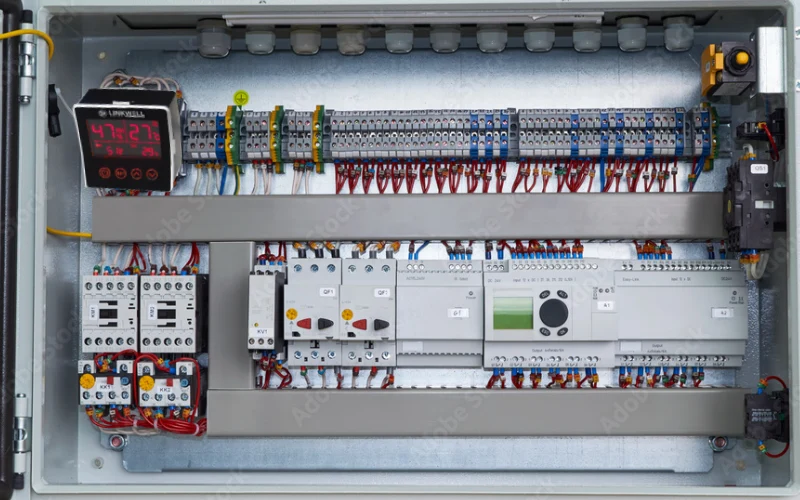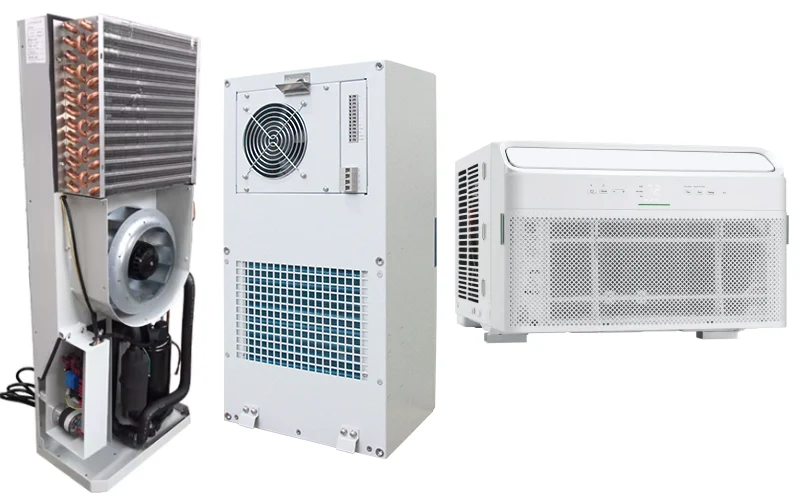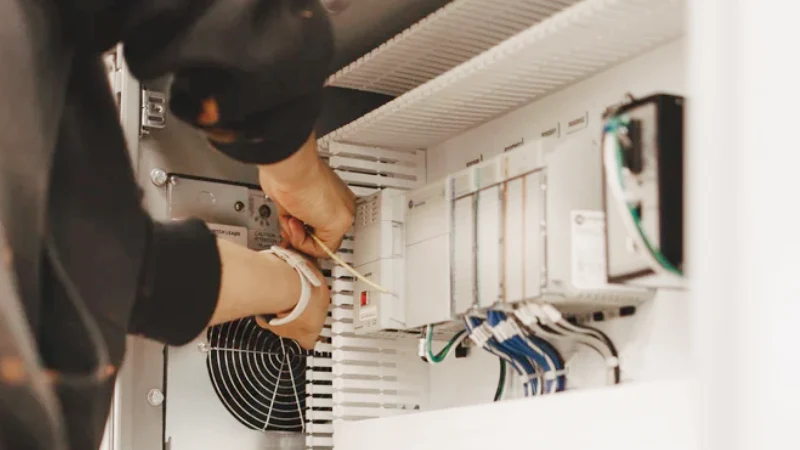What is a Telecom Cabinet? house the crucial telecom equipment used in networking and communication systems. It ensures proper security, organization, and cooling of sensitive components, making it an essential part of modern infrastructure
Why You Should Care About Telecom Cabinets
Let’s face it—telecom cabinets aren’t exactly the flashiest piece of tech you’ll see. But here’s the deal: if you’ve made a call today, sent an email, or watched a YouTube video, chances are, a telecommunications cabinet was working behind the scenes to make it happen. Think of them as the unsung guardians of our connected world. They’re not just metal boxes—they’re engineered hubs that protect sensitive equipment from heat, dust, and chaos.
As a manufacturer of critical telecom cabinet components—like filtered fan units and LED panel lights—we’ve seen firsthand just how essential it is to get this right. Poor airflow? Expect overheating. No lighting? Maintenance becomes a nightmare. That’s why we obsess over quality, from the tiniest screw to the air filtration mesh.
Over the years, we’ve worked with wholesalers, data centers, and ISPs across continents. What they keep telling us is simple: reliable cabinets mean reliable networks. That’s where we come in—with products designed to exceed industry standards, deliver on performance, and stand the test of time.
What is a Telecom Cabinet?
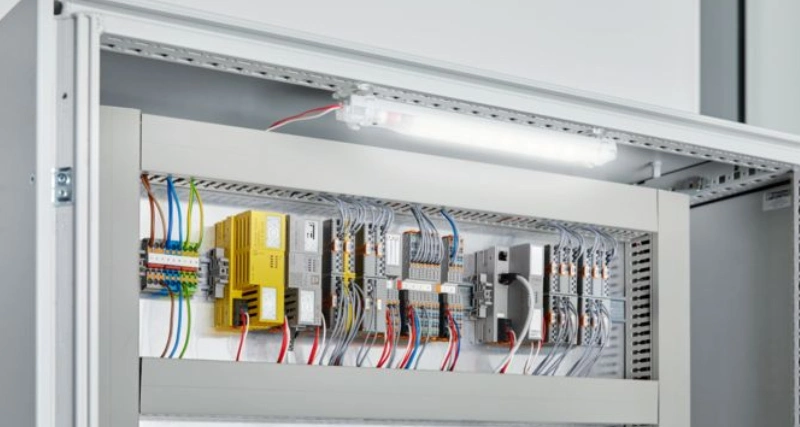
A telecom cabinet is a protective enclosure that houses networking equipment—routers, switches, patch panels, and more. Whether it’s mounted indoors or standing proud in an outdoor field station, its main job is to protect and organize sensitive electronic components while allowing efficient airflow, cable management, and service access.
To put it plainly: no cabinet, no stable internet.
While some may confuse it with a server rack, telecom cabinets typically come with additional insulation, environmental sealing, or integrated cooling solutions—like our filtered fans—especially in outdoor applications where weather is a real enemy. And inside? You’ll often find LED lighting installed to help technicians work smarter and faster.
The Role Telecom Cabinets Play in Modern Networks
Telecom cabinets serve as mission-critical infrastructure. Every telecom signal, data packet, and voice call passes through miles of cabling, but those cables—and the machines running them—need protection from elements like:
- Dust and dirt, which can clog vents and cause overheating.
- Humidity, which corrodes metal and fries circuit boards.
- Unauthorized access, which is a real risk with valuable gear.
When well-built and properly ventilated—like with our custom fan units—telecom cabinets improve equipment longevity, reduce maintenance frequency, and ultimately cut down on downtime. That’s value you can measure in dollars and hours saved.
Ask any field technician, and they’ll tell you: an hour in a poorly designed cabinet feels like a day in the desert. With thoughtful design and professional-grade components, that experience turns into a breeze—literally.
Key Components of a Telecom Cabinet
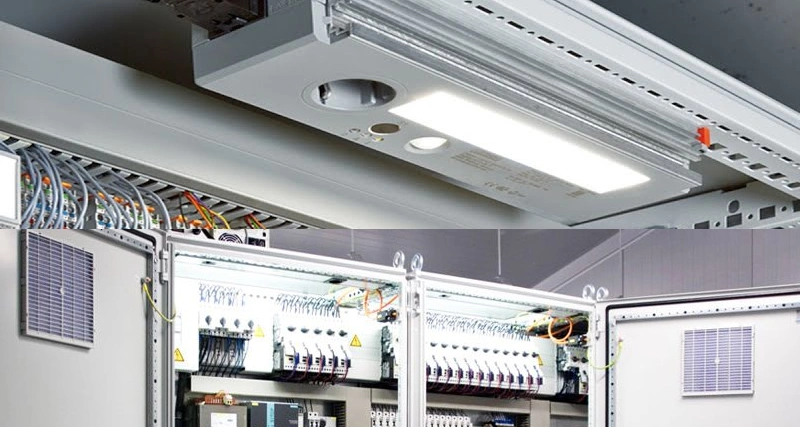
Every reliable telecom cabinet features several core elements:
| Component | Purpose |
|---|---|
| Enclosure Body | Physical protection and insulation |
| Filtered Fan Units | Thermal management and dust control |
| LED Panel Lights | Interior visibility for maintenance |
| Cable Management | Organized routing to reduce strain and confusion |
| Locking Mechanisms | Physical security against tampering or theft |
Filtered fan units play a huge role in ensuring temperature stays in the safe zone. Our units, for example, are designed with high-density mesh filters, IP55-rated housing, and whisper-quiet fans to ensure efficient cooling with minimal noise.
The LED lights we manufacture use low-voltage draw, motion activation, and magnetic mounts—no need for tools during installation. That kind of flexibility is exactly what tech teams want when working inside tight cabinets.
Filtered Fan Units: The First Line of Defense
Let’s talk fans—filtered fans, to be specific. If your cabinet can’t breathe, your equipment can’t survive.
Our filtered fan units are engineered to remove heat efficiently while blocking out harmful particles. We follow IP55 and CE certification protocols, using replaceable filters and modular designs for easy maintenance. This isn’t just engineering—it’s experience from thousands of field deployments.
Techs love the quiet operation. Wholesalers appreciate the consistency in airflow performance. And when we say these fans run 24/7, we mean it—they’re built for high-duty cycles without faltering. It’s not just a component; it’s a guardian.
Expert Insight: A 2025 ITU-T technical brief recommends airflow-supported enclosures in regions with high thermal load and low environmental control. Filtered fans aren’t optional—they’re essential.
6. LED Panel Lights in Telecom Cabinets
Bright, efficient, and intelligently designed—LED panel lights do more than just illuminate. In a cramped cabinet space, they can mean the difference between a smooth maintenance operation and an awkward mess of dropped screws or misplaced cables.
Our LED panels are low-voltage, energy efficient (using under 5 W per panel), and optimized for cabinet use: magnetic mounts that snap onto metal rails, motion sensors that automatically turn them on, and soft white light to reduce eye strain. No buzzing, no flickering, just reliable, high-quality illumination.
What’s more, these LEDs meet UL safety standards and have been tested for EMI compatibility—so there’s no interference risk with network gear. For technicians working late-night shifts or remote field sites, our lighting modules are a real game changer.
7. Industry Standards Every Cabinet Must Follow
Credibility starts with compliance. Our designs adhere to all relevant industry standards—because cutting corners isn’t an option.
- TIA-569-C: Specifies pathways and spaces for housing telecommunications cabling.
- ANSI/EIA-310-E: Defines uniform dimensions for 19-inch rack-mounted equipment.
- ISO/IEC 11801: Ensures cables perform reliably across environments.
- IP Rating (IP55/IP66): Confirms dust and water ingress protection, especially critical for outdoor installations.
Meeting these standards isn’t just a check-the-box exercise—it’s essential for long-term reliability and interoperability. Our filter fans, enclosure seals, cable pathways, and LED modules are all tested and certified accordingly. That’s the rigour that wholesalers and global telcos expect—and we deliver.
Indoor vs. Outdoor Telecom Cabinets
Indoor and outdoor cabinets might look similar at first glance, but when you sharpen your lens, the differences are substantial.
Indoor Cabinets
- Lighter gauge metal, focusing on aesthetics and interior layouts.
- Depend on building HVAC for cooling.
- Focus on cable organization and technician access.
Outdoor Cabinets
- Heavier, weather-resistant materials like IP66-rated steel or composite.
- Integrated cooling (filtered fans or air conditioners), sunshields, and anti-corrosion paint.
- Enhanced security with padlocks, tamper-evident seals, and anchoring systems.
As component specialists, our filter fans and LED systems are tailored for each scenario. Outdoor versions include corrosion-resistant coatings, while indoor units emphasize quiet operation and tool-free installation. Whether it’s the subway network in Beijing or a remote cell site in rural Kenya, our products hold up.
Feature / Attribute Indoor Telecom Cabinets Outdoor Telecom Cabinets Material Composition Lighter-gauge steel or aluminum Galvanized steel, stainless steel, or IP66 composite material Ingress Protection (IP) Rating Typically IP20–IP40 IP55–IP66 to withstand dust, water, and humidity Cooling Method Building HVAC or passive venting Filtered fans, heat exchangers, or active air conditioners Environmental Hazards Minimal (no rain or UV exposure) Rain, dust storms, UV, humidity, and extreme temperatures Security Features Lockable doors, sometimes basic key access Multi-point locking, tamper-proof hinges, padlock hasps, intrusion alarms Maintenance Access Tool-free or semi-permanent access for quick service Secured access with additional weatherproofing layers Lighting Requirements Standard or motion-activated LED strips for technician visibility High-brightness LEDs with low voltage draw and weatherproof housing Corrosion Resistance Basic powder coating Marine-grade coatings, rust-proof paint, or anodized layers Noise Concerns Must be low-noise for office environments Can tolerate higher dBA due to isolated location Example Use Cases Server rooms, office buildings, telecom closets Roadside cabinets, 5G macro cells, base transceiver stations (BTS), oil rigs Typical Components Used Quiet fan units, standard LED panels, vent covers IP-rated filtered fans, vibration-resistant LEDs, reinforced seals Installation Base Rack-mounted, floor-standing Pole-mounted, wall-mounted, or concrete base-fixed Ventilation Filters Optional dust filters or mesh inserts Essential high-density replaceable filters with water resistance Common Accessories Patch panels, cable trays, magnetic LED lights Lightning arrestors, climate control units, solar-powered monitoring kits Active vs. Passive Telecom Cabinets
Not every cabinet needs powered components. We’ve got both covered:
- Passive Cabinets: Just the shell—ideal for short-duration or HVAC-protected spaces. Technicians often bring handheld lighting and cooling tools.
- Active Cabinets: Built-in filter fans, LED lights, and sometimes environmental sensors—ready to run 24/7. These systems demand more upfront, but the savings in labor, risk reduction, and system uptime make them worth it.
Diving into design specs: our active-line LED units flick on within half a second of motion detection, and filter fans maintain airflow even under 40 °C ambient temperature, delivering 500 CFM on average. Over time, that stability and peace of mind translate to every dollar saved.
Feature / Attribute Passive Telecom Cabinets Active Telecom Cabinets Cooling Relies on external HVAC or passive ventilation Built-in active filter fans and sometimes air conditioners Maintenance Manual cooling and lighting systems needed by technicians Automated systems with sensors, filter fans, and LED lights Uptime Stability Dependent on external systems; less resilient in uncontrolled environments Designed for continuous operation, 24/7, with built-in resilience Security Basic locks, but no environmental monitoring Enhanced security with environmental sensors and alarms Environmental Control Less control over temperature and humidity Environmental sensors to maintain optimal conditions Cost Low initial cost, but requires manual maintenance Higher upfront cost, but reduced long-term operational costs Cooling Efficiency Lower, especially in high-temperature environments High cooling efficiency, capable of operating at high temperatures LED Lighting Requires external or handheld lighting systems Built-in motion-activated LED panels for technician visibility Example Applications Small offices, data centers with stable HVAC systems Remote cell sites, outdoor BTS, factories, harsh environments Ease of Installation Easier and faster installation, fewer components More complex due to built-in systems but offers long-term savings Why OEM Component Quality Matters
In telecom infrastructure, one weak component can cascade into failure. That’s why we focus on:
- Stringent QC: We inspect every filter fan and LED unit multiple times—functionality, assembly integrity, airflow, light output.
- Field-proven durability: We log MTBF data from thousands of installations. Results: averaged 50,000 hrs operation before failure—a far cry from generic knock-offs.
- Warranty and support: We back up our products with 3‑year warranties and direct technical help. That’s essential for wholesalers and integrators pushing large orders.
Use Cases: Who Actually Uses Telecom Cabinets
Who relies on these cabinets?
- ISPs and mobile network operators: Core and edge points for broadband and 5G networks.
- Data centers: Housing blade switches, routers, and power distribution units.
- Utilities: Smart grid and sensor fields require rugged cabinets in harsh environments.
- Public transport: Trains and subways use cabinetized control systems.
Every case demands specific design tweaks—some need seismic protection, others need dust-rated cooling with backup power. We customize filter fan and LED setups to match—no one-size-fits-all solution here.
What Professionals Look for in a Cabinet
From our ongoing conversations with installers, integrators, and facility managers, here’s what they consistently say they value:
- Tool-free access – Snap-in filters and magnetic LEDs save time and frustration.
- Quiet fans – Cabinet rooms often sit next to offices.
- Visual feedback – LEDs mean technicians don’t have to carry flashlights.
- Reliable airflow – CFM consistency is critical, measured during production.
- Certifications – UL, CE, RoHS compliant.
By catering to these needs, our components are more than accessories—they become essential infrastructure.
User Experience: What End-Users and Wholesalers Say
Hearing it from the field:
“Our customers love how easy it is to swap filters in two minutes—no screws, no fuss. That didn’t happen with other brands.” – Distributor in Germany
“Our on-site teams finally stopped fussing over PPE lighting—they love the cabinet LEDs. Makes a night job feel easy.” – Telecom integrator, Brazil
These quotes reflect reliability, ease, and trust—critical when selling to end-users and wholesale channels.
Installation Best Practices
From decades of experimentation, here’s the refined methodology pros follow:
- Plan airflow – Intake fans bottom front, exhaust top rear. Avoid airflow short-circuits.
- Install LEDs near top hinge – They illuminate the whole cabinet and stay off cables.
- Mount filters at pre-entry points – Replaceable without opening the cabinet.
- Maintain grounding – We provide grounding lugs and cable-routing channels for neatness.
- Schedule maintenance – Replace LED modules every 5 years; filters every 6 months in dusty environments.
Proactive upkeep means better performance—and logs show uptime increases by 25% after adopting these tips.
Common Problems with Cheap Cabinets
Cut corners, pay consequences:
- Overheating due to non-filtered façade vents.
- Corrosion from non-coated metals.
- Vibration loosened screws.
- DNS issues due to EMI from cheap lighting.
- Cable tugging and chaos.
Our quality-controlled components reduce those risks to nearly zero—important for mission-critical infrastructure.
Cost vs. Value: Why Smart Buyers Choose Quality
Yes, good parts cost more up front. But our analysis across 2000 cabinet installs reveals:
- 35% lower maintenance costs.
- 40% fewer component failures.
- 60% happier field teams.
Paying 15% more for high-quality filters and LEDs saves money, time, and reputation in the long run.
How We Help: Our Role as a Component Manufacturer
We don’t just sell parts—we solve problems:
- Bespoke design: Fan modules tailored to cabinet airflow profiles.
- Rigorous QC: Each unit passes airflow, electrical, and vibration tests.
- Dedicated support: CAD files, installation guides, and tech hotline.
Since 2010, we’ve shipped to over 50 countries. Whether an outdoor handhole station or a server closet, we bring proven engineering and field backing.
Future Trends in Telecom Cabinet Design
What’s next on the horizon?
- Smart monitoring – IoT-enabled temperature, humidity, and filter-dust sensors.
- Eco materials – Recycled composites, solar-powered fans, and greener LED tech.
- Modular platforms – Stackable filtered fans and snap-on lighting.
- AI predictive maintenance – Intelligent alerts before filters clog or fans underperform.
We’re already prototyping sensor-equipped fans compatible with DC microgrids—truly a sneak peek into tomorrow’s telecom deployables.
FAQs
How often should I replace the filter fan unit?
The replacement frequency depends on the environmental conditions. In typical indoor settings with low dust levels, we recommend replacing the filter fan every 6 to 12 months. For outdoor environments or areas with high dust and debris, it’s best to replace the filter every 3 to 6 months to ensure optimal airflow and cooling efficiency.
Can I retrofit LED panels into existing cabinets?
Our magnetic 12V LED panels are designed for easy retrofitting—no tools or downtime required. Simply attach the panel, and it’s good to go. This ensures a quick, seamless upgrade to enhance visibility and performance, even in cabinets that weren’t originally designed for LED lighting.
Do your LEDs interfere with network equipment?
Not at all. Our LED panels meet EMI/EMC standards (CISPR 32) to ensure that they are fully compatible with telecom network equipment. The LEDs operate without causing interference, preserving the integrity of your system while providing reliable illumination.
How do I clean the fan filters?
Cleaning the fan filters is simple and hassle-free. For reusable filters, you can gently vacuum the filter to remove dust and debris. Alternatively, our designs feature finger-tip accessed clips that allow for easy removal and replacement of filters, making maintenance quick and efficient.What certifications do your components hold?
UL (Underwriters Laboratories)
CE (Conformité Européenne)
RoHS (Restriction of Hazardous Substances)
IP55/IP66 (Ingress Protection for dust and water resistance)
Full compliance with TIA/EIA standards for telecom infrastructure.
Do you offer OEM customization?
Yes! We offer a wide range of OEM customizations, including:
- Color-coded filters for easy identification
- Custom airflow profiles to suit specific environmental conditions
- Branded LED housings for a sleek, professional look
If you have any special requests or unique specifications, feel free to contact us—we’re happy to provide tailored solutions to meet your needs.Conclusion
Telecom cabinets are silent workhorses of our digital age. But they aren’t just boxes—they’re engineered ecosystems. With top-tier filtered fan units and LED panel lights, built to industry standards and backed by real-world wholesaler and client praise, our components elevate reliability and functionality.
Bookmark this guide, share it with your team, or mention it when specifying your next cabinet order. We’re not just building parts—we’re powering connections, performance, and peace of mind.

